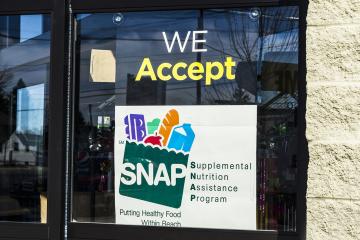
Overcoming administrative burdens: Strategies to increase access to health insurance in the United States

A new J-PAL policy insight highlights evidence from randomized evaluations on the impact of informational “nudges”—strategies designed to inform individuals about various aspects of health insurance and influence behavior without changing legal or economic systems—on health insurance take-up. Yet nudges are just one tool to help individuals overcome barriers to enrollment, also known as “administrative burdens.” In this post, we review additional evidence-based interventions that target and reduce administrative burdens to increase insurance enrollment and maintenance, and highlight where more research is needed.
Health insurance in the United States
The health insurance landscape in the United States is uniquely complex and hard to navigate. Getting coverage is also often expensive for individuals. The majority of adults are privately insured by their employers. The second largest insurers are public insurers, such as Medicaid, for low-income individuals, and Medicare, for all adults over 65. Individuals not covered by those insurers can access health insurance on the Health Insurance Exchange or Marketplace (often called the ACA Marketplace, named for the Affordable Care Act which established the platform).
Currently, uninsurance rates are historically low, partly due to pandemic-era policies that did not require individuals on Medicaid to recertify and lowered premiums for individuals insured through the ACA Marketplace. Despite these gains, roughly 10 percent of individuals were uninsured in 2021. While the majority of individuals cite cost as their main barrier to obtaining insurance, many others cite the complexity of the health insurance system as the reason they are not insured.
Administrative burdens when accessing health insurance
Challenges imposed on individuals that make it difficult to access or maintain a benefit that they are eligible for are called administrative burdens. The costs associated with these burdens fall into three general categories: learning costs, psychological costs, and compliance costs.
Learning about and accessing public programs is often confusing and inaccessible, resulting in learning costs. When seeking access to health insurance, these costs arise when individuals spend time and energy trying to understand whether they are eligible for Medicaid or a subsidized plan on the ACA Marketplace. They may also need to figure out how to apply and what services and doctors are covered under each plan.
There is also significant time and effort required to submit the paperwork necessary to apply for a health insurance program, resulting in compliance costs (also a key component of the “Time Tax”). Completing complex enrollment forms, collecting the necessary documentation, and choosing from extensive and often confusing plan options on the ACA Marketplace or in Medicare Part D, in which individuals select a prescription drug plan, all lead to compliance costs.
Psychological costs result from the stigma associated with receiving government assistance. These kinds of costs can arise in particular among immigrant communities who often face changing “public charge” policies and may be unsure of the consequences of Medicaid participation on their legal status.
These costs have major implications for the health and well-being of individuals across the United States. Administrative burdens disproportionately affect low-income individuals and people of color, exacerbating existing inequities. Access to insurance has been shown to have many beneficial health outcomes, including a decrease in mortality. For states, there are substantial administrative and personnel costs associated with churn—when people who are enrolled in a program do not complete recertification in time or have mistakes in their application, lose access to a program, and then need to reapply to regain access. And for private and public insurers, administrative burdens may also push younger, healthier individuals out of the insurance pool, making it more unstable and risky, which may lead to higher costs.
Evidence from randomized evaluations on increasing take-up
One evidence-based solution to reducing administrative burdens is nudges, which are strategies designed to inform individuals about various aspects of health insurance and influence behavior without changing legal or economic systems.
A J-PAL policy insight reviewed eleven randomized evaluations and found that informational nudges have small but meaningful impacts on both health insurance take-up and ensuring individuals switch to the plans that best serve their needs in the United States. While more personalized or intensive outreach may be impactful, this review also demonstrates that light-touch, non-personalized, cost-effective interventions can still encourage people to take up health insurance or switch to a more optimal plan with lower premiums for the same or similar coverage.
These nudges address a variety of barriers to health insurance take-up, from lack of awareness of insurance eligibility or benefits and mistakenly choosing a suboptimal insurance plan (learning costs) to the need for application assistance, particularly in-language assistance, and procrastination (compliance costs).
Additional evidence-based strategies to lower administrative burdens
While the policy insight focuses on the growing body of literature on the role of nudges in increasing health insurance take-up, other key strategies could also lower administrative burdens in health care. These include:
Streamlined enrollment
Streamlined enrollment strategies, which not only inform individuals of eligibility or offer assistance but change the enrollment process to require fewer steps, are promising interventions that would reduce both learning and compliance costs.
A J-PAL North America-funded randomized evaluation demonstrated that an enrollment strategy in which eligible individuals could enroll simply by checking a box and mailing the form back in a pre-paid envelope increased health insurance take-up by 11 percent. This tactic proved more effective than generic reminder letters, which increased enrollment by roughly 8 percent.
Comprehensive case-management
Dedicated case managers, who provide information on program eligibility, help families complete insurance applications, act as a liaison with insurance markets, and assist in maintaining coverage. They may be particularly effective at helping populations that generally have less contact with the government byreducing learning, compliance, and psychological costs. A randomized evaluation from 2005 found that case managers significantly improved the likelihood of families being insured. However, more contemporary research is needed in this area.
Automatic enrollment and automatic retention
Automatically enrolling eligible individuals into a plan or automatically retaining eligible individuals would reduce compliance costs. For example, before the passage of the ACA, Massachusetts used a form of automatic enrollment for those who qualified for fully subsidized coverage but hadn’t chosen a plan and enrolled them in a state-selected plan. This strategy increased enrollment and, generally, those who were automatically enrolled were also younger and healthier than other enrollees. Similarly, automatic retention, wherein enrollees who fell behind on premium payments were automatically transitioned to a zero-premium plan if one was available, rather than losing coverage, has also been shown to decrease coverage loss. Automatic enrollment could also manifest as a Marketplace reassigning individuals to a lower-premium plan with the same benefits, while also allowing them an opportunity to “opt out” if they wish.
By investing in more evidence-based strategies and ongoing evaluation, we can continue to decrease administrative burdens, increase the number of people enrolled in health insurance, and promote the well-being of individuals and communities across the United States.
This post is part of an ongoing series on interventions to overcome administrative burdens and increase access to public programs in the United States. The second piece focused on increasing take up of federal student aid.
Related Content

The effect of nudges on health insurance take-up in the United States

Too complicated, too confusing: why more small businesses aren’t applying for coronavirus relief loans, and what we can do to reach them

